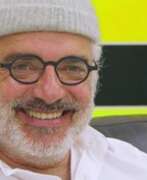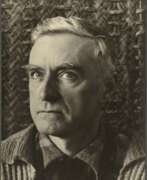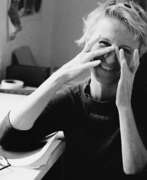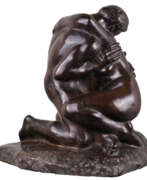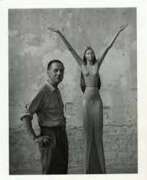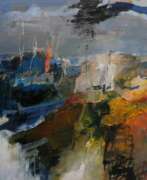France Contemporary art


Berenice Alice Abbott was an American photographer best known for her portraits of between-the-wars 20th century cultural figures, New York City photographs of architecture and urban design of the 1930s, and science interpretation in the 1940s to 1960s.


Henri-Georges Adam was a French engraver and non-figurative sculptor of the École de Paris, who was also involved in the creation of numerous monumental tapestries. His work in these three areas is regarded as among the most extensive of the twentieth century.


Yaacov Agam, an Israeli kinetic and optical artist born on May 11, 1928, is celebrated for revolutionizing the visual arts with his dynamic and interactive creations. Agam's pioneering work extends beyond traditional static art forms, inviting viewers into a transformative experience that changes with perspective and movement. His art, deeply rooted in his Jewish heritage and mysticism, eschews representational imagery for abstract, geometric forms and vibrant colors, engaging the observer's perception to complete the visual experience.
Notably, Agam's contributions to kinetic art have not only garnered him international acclaim but also led to his works commanding the highest prices among Israeli artists at auction. His innovative "Agamographs" use lenticular printing to create illusions of depth and motion, highlighting his fascination with the interplay between art, viewer, and the temporal dimension. Agam's significant exhibitions include retrospectives at the Musée National d'Art Moderne in Paris and the Guggenheim Museum in New York. His achievements are further recognized through multiple awards and the establishment of the Yaacov Agam Museum of Art in his hometown of Rishon LeZion, Israel, dedicated to his vision of art in motion.
For collectors and art and antiques experts, Agam's work represents a profound exploration of perception, time, and spirituality, offering a unique and engaging experience. His art invites us to see beyond the visible, reminding us of the ever-changing nature of reality and our active role in its perception. To stay updated on new product sales and auction events related to Yaacov Agam, sign up for updates and immerse yourself in the dynamic world of one of the most influential modern artists.


Wolfram Aïchele was an artist from Baden-Württemberg in Southern Germany, son of renowned animal artist Erwin Aichele. After training as a sculptor, he studied religious and Byzantine art, drawing inspiration from his pilgrimage to Serbia, Kosovo, Macedonia, and Mount Athos. Aïchele focused on painting icons using egg tempera, aiming to revive the pure iconographical style corrupted in the 19th century. He later moved to Paris, where he explored various influences such as Eastern European folk art, Persian miniatures, and modern artists like Chagall and Klee. Aïchele's work transitioned to a unique blend of figurative and abstract art, primarily expressed through watercolors and painted collages.


Harold Ambellan is an American painter and sculptor.
He studied sculpture and fine art in Buffalo before moving to New York City. The human figure is central to Harold Ambellan's work. He created monumental figures and drew extensively, leaving thousands of drawings. Ambellan was one of the participants in Roosevelt's Federal Art Project, which hired hundreds of artists during the Great Depression who collectively created more than 100,000 paintings and over 18,000 sculptures.
Ambellan remained committed to figuration in both his sculpture and painting. He was elected president of the Sculptors Guild of America in 1941, and that same year his work was exhibited in group shows at the Metropolitan Museum of Art in New York and the Academy of Fine Arts in Philadelphia.
In 1944, Ambellan participated in the liberation of Normandy as part of the U.S. Navy, then taught three-dimensional art at the Workshop School in New York City. In 1954, for political reasons, Ambellan moved to France and remained there for the rest of his life, working and exhibiting throughout Europe.
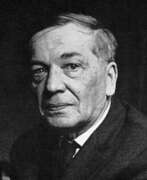

Mikhail Fedorovich Andrienko-Nechytailo (Russian: Михаил Фёдорович Андриенко-Нечитайло) was a Russian artist known for his contributions to the avant-garde movement. Born in 1894, he became renowned for his innovative approach to painting, stage design, and illustration. Andrienko-Nechytailo’s work is celebrated for its unique blend of Constructivism and Cubism, which set him apart from his contemporaries.
One of his special features was his ability to combine geometric forms with a vibrant color palette, creating visually striking compositions that challenged traditional artistic conventions. His works often explored themes of abstraction and the intersection of art and technology. His notable pieces are housed in prestigious collections, including the Tretyakov Gallery in Moscow and the Russian Museum in Saint Petersburg.
Collectors and art experts admire Andrienko-Nechytailo for his visionary approach and lasting impact on modern art. His legacy continues to influence contemporary artists and is a testament to his skill and creativity.
Sign up for updates on new product sales and auction events related to Mikhail Fedorovich Andrienko-Nechytailo. Stay informed about opportunities to add his remarkable works to your collection.


Aslan, real name Alain Gourdon, French artist, illustrator and sculptor. He is best known in France for his pin-up work. He studied at the Ecole Nationale des Beaux-Arts in Paris.
Aslan was also the author of busts and statues of many famous people (actors, politicians, singers). His works are often characterised by grace, courage and ardour. Aslan masterfully conveys the beauty and emotional depth of the female body, playing with lines, shapes and light. His compositions often evoke mixed feelings: they are both elegant and provocative, evoking a dialogue between eroticism and art.
Aslan's work has a surreal element to it, lending an air of mystery and singularity to his work. He combines reality and fantasy with ease, creating a world full of unpredictable and mystical images.


Daniel Authouart is a French painter, draughtsman and lithographer.
He studied at the École des Beaux-Arts in Rouen and lives and works in the same city. Authouart is known for his hyper-realistic paintings and lithographs on themes of modern life. He also created book bindings, posters and theater sets.


Lewis "Duke" Baltz was an American visual artist, photographer, and educator. He was an important figure in the New Topographics movement of the late 1970s. His best known work was monochrome photography of suburban landscapes and industrial parks which highlighted his commentary of void within the "American Dream". His work is focused on searching for beauty in desolation and destruction. Baltz's images describe the architecture of the human landscape: offices, factories and parking lots. His pictures are the reflection of control, power, and influenced by and over human beings. His books and exhibitions, his "topographic work", such as The New Industrial Parks, Nevada, San Quentin Point, Candlestick Point, expose the crisis of technology and define both objectivity and the role of the artist in photographs. He wrote for many journals, and contributed regularly to L'Architecture d'Aujourd'hui. Baltz's work is held in the collections of the Solomon R. Guggenheim Museum, Metropolitan Museum of Art, Tate Modern, Los Angeles County Museum of Art, Whitney Museum of American Art etc.


Vladimir Davidovich Baranov-Rossine (Russian: Владимир Давидович Баранов-Россине) was a master of the Russian avant-garde, a prolific painter, sculptor, and inventor, whose work significantly contributed to the Cubo-Futurism movement. Born on January 1, 1888, in Kherson, he was originally named Shulim Wolf Leib Baranov but is best known by his pseudonym, Daniel Rossine. His early artistic education took place in Odessa and then at the St. Petersburg Academy of Arts, laying the groundwork for his future as a revolutionary artist.
In 1910, Baranov-Rossine moved to Paris, a pivotal move that introduced him to the burgeoning European avant-garde scene. It was there, alongside other notable artists such as Marc Chagall, Osip Zadkine, Alexander Archipenko, and Chaim Soutine, that he became an inhabitant of the famous Parisian house "La Ruche." His innovative work, particularly the invention of the Optophonic Piano, which projected colors in sync with music, underscored his commitment to blending art and technology, a hallmark of his career.
Tragically, Baranov-Rossine's life was cut short when he was arrested by the Gestapo in 1943 and subsequently died in Auschwitz in 1944. Despite his untimely death, his legacy lives on through his contributions to modern art and technology. His works can be found in various museums and galleries, celebrated for their vibrant expression and avant-garde techniques that continue to inspire artists and collectors alike.
For those intrigued by Vladimir Davidovich Baranov-Rossine's pioneering work and its lasting impact on the art world, signing up for updates on new product sales and auction events related to this avant-garde master is highly recommended. This ensures enthusiasts and collectors are always informed about the latest opportunities to engage with Baranov-Rossine's remarkable legacy.


André Beaurepaire was a French artist and scenic designer.
Beaurepaire studied at the École des Beaux-Arts in Tours, and later in Paris at the École Nationale Supérieure des Arts Décoratifs. He worked as a painter and a graphic artist, and also designed sets and costumes for theater productions and films.
Beaurepaire was particularly well-known for his work as a scenographer, and collaborated with many major French directors and choreographers, including Jean-Louis Barrault, Roger Planchon, and Maurice Béjart. He designed sets for a number of classic works of theater, including Shakespeare's "Hamlet" and "Macbeth," Molière's "The Misanthrope," and Jean Anouilh's "Antigone."
In addition to his work as a scenographer, Beaurepaire continued to paint throughout his career, and his works were exhibited in galleries and museums in France and abroad. His paintings are characterized by their vibrant colors and dynamic compositions, often featuring abstract or geometric shapes.


Erwin Bechtold is a German abstract painter and sculptor. He spent some time in Paris, where he had the opportunity to work with Fernand Léger.
Erwin Bechtold was the founder of the artist's group Ibiza 59, whose members sought to create art free of subjective expression. Bechtold's paintings from this period were characterised by minimal geometric forms and the use of a monochromatic colour palette.
Later in his career, Bechtold began experimenting with sculpture, creating large-scale works that explored the relationship between form and space.


Valérie Belin is a French art photographer. She lives and works in Paris.
Her work takes the form of photographic series. In the 2000s she started using digital post-production tools which gave her greater freedom to change and control the chromatic values of the prints. She now produced her first series in colour. In 2009 Belin began to use other kinds of digital manipulation, heightening the hybrid, graphic and artificial dimension of her work. These include solarisation and overprinting. Since then, she has also worked with other abstract vectorial forms, like digital "readymades" found on the internet, which she reworks on the computer, melding them with her images.


Neïl Beloufa is a French-Algerian artist born in 1985 in Algeria and raised in France. He currently lives and works in Paris. Beloufa's work covers a wide range of media, including sculpture, video and installations, and often deals with topics related to social and political issues.
Belufa's installations often use a combination of found objects, industrial materials and digital technologies such as screens and projectors. He often creates an immersive environment that encourages the viewer to physically and emotionally interact with the work.
One of Belufa's most famous works is Colonies, an installation that was exhibited at the Hammer Museum in Los Angeles in 2017. The installation was a series of interconnected rooms filled with sculptures, videos and soundscapes that explored themes related to colonisation and global power structures. Belufa's work has been exhibited internationally, including at the Palais de Tokyo in Paris, the New Museum in New York and the 2015 Venice Biennale. He has received numerous awards and prizes, including the Audi Talent Award in 2011 and the Marcel Duchamp Prize in 2015.


Charles Bézie is a French artist, representative of the neo-minimalist movement, who lives and works in Paris.
He graduated from the Académie Joulian in Paris and initially tried to create in his paintings a contrast to Malevich and Mondrian. However, he later changed his technique and style. Bezie applies different layers of paint to the canvas, partially overlapping each other, and it is the light that reveals the nuances and shades of the thin and wide stripes. This is what he calls "background animation. Bezie continues the tradition of constructivist art that emerged in the early 20th century.


Jean-Charles Blais is a French artist best known for his paintings and drawings exploring themes of identity, memory and representation.
Jean-Charles Blaise studied at the École des Beaux-Arts in Rennes before moving to Paris in the 1980s. Blais' early work was influenced by the Neo-Expressionist movement of the 1980s, and his paintings and drawings were often characterised by bold, gestural strokes and figurative imagery. Over time, however, his style evolved to become more minimalist and abstract, with an emphasis on simplified forms and lines.


Francois Boisrond is a contemporary French painter. He studied from 1977 to 1980 at the National School of decorative Arts. In 1981 he became involved in the Free Figuration movement. Inspired by visual products (advertising products, posters, stickers, video games etc.), cartoon characters, and by using acrylic paint, Francois Boisrond’s works are colourful, figurative and enigmatic, and his simplified shapes are often outlined in black. He portrays mainly characters, frequently symbolic in everyday situations, but he also depicts urban, maritime or rural landscapes. Besides this Boisrond creates humanitarian and publicity posters. Since the 1990’s the artist has become interested in an imaginary public and the everyday life that invades each and every one of us.


André Borderie is a French artist and sculptor.
Classically trained as a technician and working as a civil servant in the telecommunications sector, André Bordari met the poster artist Paul Colin in 1942, who encouraged him to take up painting.
A fateful meeting with the Austrian sculptors Vera and Pierre Sekely in 1946 led Bordari to the decision to devote himself entirely to art.
André Borderi is known for his paintings, tapestries and ceramics.


Arun Bose was a prominent Indian artist born in Dhaka, then part of British India (now Bangladesh). He received his art education in Calcutta at the Government College of Arts and Crafts, graduating in 1955. Thereafter, he actively created and taught in Calcutta for the next seven years. In 1962, he travelled to the West where he learnt etching and studied mural techniques at the École Nationale Supérieure des Beaux-Arts in Paris. His many prints were made in aquatint and etching techniques with simultaneous colour printing. He later moved to New York, where he studied at the Pratt Graphic Centre and in 1968 received a scholarship from the Third John D. Rockefeller. He was also part of Robert Blackburn's workshop and taught printmaking himself at Queens College.
Arun Bose's paintings and prints are characterised by bright colours and abstraction, making his work unique and important in the art world.


Édouard Boubat was a French photojournalist and art photographer.
In 1943, he was subjected to service du travail obligatoire, forced labour of French people in Nazi Germany, and witnessed some of the horrors of World War II. He took his first photograph after the war in 1946 and was awarded the Kodak Prize the following year. He travelled internationally for the French magazine Réalités, where his colleague was Jean-Philippe Charbonnier, and later worked as a freelance photographer. French poet Jacques Prévert called him a "peace correspondent" as he was humanist, apolitical and photographed uplifting subjects.


Louise Joséphine Bourgeois was a French-American artist. Although she is best known for her large-scale sculpture and installation art, Bourgeois was also a prolific painter and printmaker. She explored a variety of themes over the course of her long career including domesticity and the family, sexuality and the body, as well as death and the unconscious. These themes connect to events from her childhood which she considered to be a therapeutic process. Although Bourgeois exhibited with the Abstract Expressionists and her work has much in common with Surrealism and Feminist art, she was not formally affiliated with a particular artistic movement.


André Bourrié, full name André Georges Jules Louis Bourrié, was a French painter.
He was known for his city and seascapes, which used oil paint, sometimes mixed with chalk and sand to create a textural effect on the canvas.
Bourrier's work has been exhibited in galleries and museums around the world, including the Centre Pompidou in Paris and the Galleria Bohemia in New York.


Michel Boyer was one of the last great interior designers who remained true to the principles of modernity.
Boyer collaborated with Dior, Lanvin, Balmain and designed interiors for hotels, embassies and numerous corporate headquarters. His private clients have included Elie de Rothschild, Liliane Betancourt and Karim Aga Khan.


Yves Brayer was a French painter and lithographer known for his landscapes, portraits and still lifes.
Brayer studied at the École Nationale Supérieure des Beaux-Arts in Paris and then in Rome. He was influenced by classical art and inspired by Mediterranean landscapes, which he often depicted in his paintings. He was also interested in the culture of ancient Greece, which influenced his work.
Brye's early work was inspired by the Cubist and Surrealist movements. He was a founding member of the Paris School, a group of artists working in the French capital in the mid-twentieth century. He was also a member of the French Academy of Fine Arts and a Knight of the Legion of Honour.
Bryeux's work has been exhibited in prestigious galleries and museums around the world, including the Louvre in Paris, the Museum of Modern Art in New York and the National Museum of Western Art in Tokyo. His paintings are in many private collections.
Over the course of his career, Brye has received numerous awards and honours, including the Grand Prix de Rome and the Prix de l'Institut de France. He is considered one of the most important French artists of the 20th century.


James Brown was an American-born painter active in Paris and Oaxaca, Mexico. He was most well known in the 1980s for his rough painterly semi-figurative paintings, bearing affinities to Jean-Michel Basquiat and East Village painting of the time, but with influences from primitive art and classical Western modernism. His work has taken on several styles over the years but maintains a hand-made look combining concerns of the modernist tradition with motifs and spiritual interests from tribal art. Much of his work is a non-realistic but contains depictions or signs of recognizable faces or objects. However, the line between representation and abstraction is often a difficult one in his work. Besides paintings Brown has also produced sculptures and series of prints at various points in his career, and in the 1990s started to heavily utilize collage.


Guillaume Bruère is a French painter, drawer, sculptor and performer. He lives and works in Berlin.
Guillaume Bruère graduated from the Ecole des Beaux-Arts de Nantes (DNSEP) in 1999, then from the Ecole Européenne Supérieure de l'Image in Poitiers in 2003.
Fascinated by the major artists of art history (Holbein, Dürer, Rembrandt, Goya, Van Gogh, Giacometti, Picasso, Bacon), Guillaume Bruère has been working since 2009 in many museums and prestigious institutions (e.g. Kunsthaus Zürich, Musée Picasso Paris, Fondation Vincent Van Gogh Arles) to reinterpret their works, notably through drawing.
From his confrontation with the art of the past (Egyptian, Greek, Mexican, heraldic art, etc.), a singular, dense universe of extraordinary vitality emerges through the use of colour, the expressiveness of his gesture, the sureness of his line, and collage, which can be found in many of his drawings, but also in his painting, sculpture and performances.


Bernard Buffet was a French artist renowned for his distinctive style of painting, printmaking, and sculpture. His work, characterized by expressive, angular lines and somber themes, has captivated collectors and art enthusiasts worldwide. Buffet's art, deeply influenced by the post-war period in France, reflects themes of despair, loneliness, and the human condition, often portrayed through his iconic clowns and desolate landscapes. His approach to art, marked by stark compositions and a vivid portrayal of existential angst, positioned him as a leading figure in the modern expressionist movement.
Buffet's career was meteoric from its onset; by his early twenties, he was celebrated alongside cultural icons of the time, earning him a spot among the "Fabulous Five" of post-war France. Despite his early acclaim, Buffet's later years were marked by controversy and a decline in popularity, as shifts in artistic trends and criticism over his lifestyle choices overshadowed his contributions. Nevertheless, his work remained prolific, with more than 8,000 paintings to his name, illustrating an unwavering commitment to his art until his tragic death in 1999.
Today, Bernard Buffet's legacy is undergoing a renaissance, with a renewed appreciation for his artistic achievements. Exhibitions and retrospectives across the globe, particularly in Japan and Europe, have reignited interest in his oeuvre, showcasing the enduring relevance of his work. Notably, the Bernard Buffet Museum in Japan, founded during his lifetime, stands as a testament to his impact and the global admiration for his art.
For collectors and experts in the field of art and antiques, Buffet's work offers a unique insight into the complexities of the human psyche and the existential dilemmas of the 20th century. His ability to evoke profound emotional responses through his distinctive visual language makes his work highly sought after in the art market today.
To stay informed about new product sales and auction events related to Bernard Buffet, we encourage you to sign up for updates. This subscription service is tailored specifically for enthusiasts keen on exploring the profound legacy of Bernard Buffet, ensuring you remain at the forefront of notable developments in the art world.
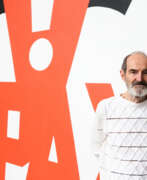

Erik Vladimirovich Bulatov (Russian: Эрик Владимирович Булатов) is a Soviet and Russian avant-garde artist of the XX-XXI centuries. His paintings are an experimental confrontation of modernist style and traditional painting. The main principle of Bulatov's paintings is the confrontation of the real space and the pictorial plane.
Since 1989, Bulatov lived in New York, and in 1992, he moved to the capital of France, where he lives and works to this day, sometimes visiting Russia.
Bulatov's works are in constant demand at auctions of contemporary art, he is considered one of the most expensive contemporary Russian artists. For example, his work "Soviet Cosmos" was sold for about $1.6 million at the Phillips auction.


Daniel Buren is a French conceptual artist. He is one of the founders of the art group BMPT. Considered to be one of the most 'expensive' living French artists.
Since 1966, Daniel Buren created an aesthetic form which allowed him to concentrate exclusively on the position of the artwork in space: he focused on a series of alternating white and coloured stripes. This creative strategy became his hallmark.
Buren's striped columns (composition "Two Levels"), installed in 1986 in the courtyard of the Parisian Palais-Royal, which provoked protest from Parisians, later became a prominent landmark in the French capital.


Pol Bury was a Belgian sculptor and artist, celebrated for integrating movement into his sculptures and pioneering the kinetic art movement. Born on April 26, 1922, Bury began as a painter in the Jeune Peintre Belge and the COBRA groups, later transitioning to sculpture. His most renowned work, the fountain-sculpture 'L'Octagon', is a highlight in San Francisco. His innovative art was acknowledged when his work was auctioned at Christie's in 2008, recognizing the unique nature of his contributions to art.
Pol Bury's creations can be found in permanent collections, like that of the Chelsea Art Museum, amongst others.
.


Harry Callahan was an American photographer and artist who is best known for his innovative and experimental work in the mid-20th century. He was began his artistic career as a painter before turning to photography.
Callahan's photographic work was characterized by his interest in abstraction, pattern, and form. He often photographed everyday objects and scenes, such as street signs, buildings, and landscapes, and used his camera to explore the beauty and complexity of the world around him.
Callahan was also known for his work as a teacher, and he taught photography at the Rhode Island School of Design for many years. His students included notable photographers such as Aaron Siskind and Ray K. Metzker, and he was known for his rigorous and challenging approach to teaching.
Callahan's legacy as an artist and photographer continues to influence contemporary photography and art. His innovative techniques and distinctive style continue to inspire new generations of artists, and his work is recognized as a significant contribution to the history of photography.
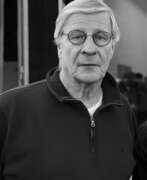

Louis Cane is a contemporary French painter, sculptor and furniture designer. Louis Cane attended the National School of Decorative Arts in Nice then the Superior School of Decorative arts in Paris in 1961. Cane was a part of the Supports/Surfaces Movement in France that lasted from 1969 to 1972 and co-founded and edited the Peinture, Cahiers Theoriques. In 1978, began sculpting again. They consisted of female figures in a traditional style. Cane focused on the concept of deconstruction of the canvas. By 1970, Cane transitioned into a series of cut-out paintings, the toiles découpées, which he worked with for several years. From 1972 to 1972, he produced a series called Sol/Mur as apart of the Supports/Surfaces movement. In 1978, Cane went from abstract painting to figuration. He reflected on the history of pictorial forms. He also started integrating sculpture into his practice. The statues were almost exclusively female occasionally appearing in form of burlesque or baroque expressionism.


Roger Capron, birth name Roger Henri Louis Capron, is a French ceramic sculptor and draftsman.
Capron studied applied arts in Paris and in 1946 founded a pottery workshop, l'Atelier Callis, in Vallauris, employing up to 120 people at various times. Capron won many awards, including the Grand Prix International de la Céramique in 1970, and in 1983 he founded the now famous Atelier Capron.
Roger Capron's creations often use clay tiles or enameled lava tiles, traditionally used for decorative panels. This recognizable way of using ceramics in furniture and objects has become the designer's trademark. Capron was the first to put his ceramic expertise at the service of semi-industrial production. The workshop developed into a small factory and gained an international reputation.


Henri Cartier-Bresson was a French artist renowned for his groundbreaking work in photography, particularly in the realms of photojournalism and street photography. Born on August 22, 1908, in Chanteloup, France, Cartier-Bresson's early artistic endeavors were in painting, which he began studying at the age of five. His transition to photography was marked by his adoption of a 35mm Leica camera in 1931, a tool that became synonymous with his work.
Henri Cartier-Bresson's photography is celebrated for its unique blend of spontaneity and composition, capturing moments that reveal deeper truths about their subjects. His theory of "the decisive moment" – that is, capturing an event that is ephemeral and spontaneous, yet significant – has had a profound influence on the field of photography. His work has been exhibited in prestigious venues such as the Museum of Modern Art in New York and is held in high esteem in art collections worldwide.
In addition to his personal achievements, Henri Cartier-Bresson was a co-founder of Magnum Photos in 1947, a cooperative agency for worldwide photographers that significantly influenced photojournalism. Later in his career, Cartier-Bresson returned to painting and drawing, demonstrating his lifelong commitment to the arts.
For art collectors and experts, Henri Cartier-Bresson's work offers a pivotal exploration of 20th-century photography, blending artistic vision with the unguarded moments of life. His influence extends beyond his images, shaping the way we perceive and engage with visual narratives.
To explore more about Henri Cartier-Bresson's influential career and works, and to stay updated on exhibitions or sales featuring his photography, you might consider subscribing to updates from art institutions or galleries that frequently showcase his work.


Jean Carzou (Armenian: Ժան Գառզու), birth name: Garnik Zouloumian (French: Karnik Zouloumian; Armenian: Գառնիկ Զուլումեան) was an Armenian-French artist: painter, graphic artist, scenographer, book illustrator, representative of the Paris School. Years of creative activity - 1925-1999. The characteristic definition of Karzu's works is "magic realism".
Jean Carzou's works demonstrate a unique combination of realism and fantasy. His ability to give ordinary scenes mystery and intrigue distinguishes his work. Depictions of bustling city streets, serene landscapes or poignant human figures evoke a sense of contemplation and encourage viewers to delve deeper into the subject matter of each work.


Jean-Pierre Cassigneul is a French artist known for his stylized paintings of women in fashionable clothing and elegant interiors. He was studied at the École Nationale Supérieure des Beaux-Arts in Paris.
Cassigneul's paintings often feature women with long necks, almond-shaped eyes, and vividly colored clothing set against simple yet elegant backgrounds. He has been influenced by the work of Henri Matisse, Pierre Bonnard, and Edouard Vuillard, as well as Japanese woodblock prints.
Cassigneul's work has been exhibited in galleries and museums around the world, including the Tokyo Museum of Modern Art, the National Museum of Fine Arts in Buenos Aires, and the Museum of Modern Art in Paris. His paintings are also held in the collections of many prestigious institutions, including the Musée d'Art Moderne de la Ville de Paris and the Museum of Modern Art in New York.
In addition to his paintings, Cassigneul has also worked in other media, including lithography and book illustration. He has created illustrations for works by Gustave Flaubert, Paul Verlaine, and Charles Baudelaire, among others.
Cassigneul continues to work and exhibit his art today, and is considered one of the leading figures of the contemporary French art scene.


César (born Cesare Baldaccini) was a noted French sculptor.
César was at the forefront of the Nouveau Réalisme movement with his radical compressions (compacted automobiles, discarded metal, or rubbish), expansions (polyurethane foam sculptures), and fantastic representations of animals and insects.


Jules Chéret, a French artist and lithographer, revolutionized the world of advertising and poster art in the late 19th and early 20th centuries. Born in Paris in 1836, Chéret's innovative techniques and vibrant style earned him the title of "the father of the modern poster," a distinction that highlights his significant contributions to the graphic arts. His work was greatly influenced by the Rococo movement, drawing inspiration from artists like Jean-Honoré Fragonard and Antoine Watteau, which is evident in his joyful and lively representations of women, known as 'Chérettes.' These figures broke away from traditional depictions, celebrating femininity with elegance and a sense of freedom, thereby contributing to a more open atmosphere in Parisian society.
Chéret's mastery of lithography, a printing technique he believed would dominate over traditional letterpress, allowed for the production of colorful and dynamic posters. His approach to lithography was revolutionary; he simplified the chromolithographic process by using three primary colors and treated the limestone with a painterly technique that included animated brush lines and soft washes. This enabled him to produce posters that were not only advertisements but also highly regarded pieces of art. His first major commission came in 1858 for Jacques Offenbach's "Orpheus in the Underworld," marking the beginning of a prolific career that would redefine poster art.
Chéret's legacy is vast, with his works now coveted by collectors and art enthusiasts around the world. In 1895, he created the "Maîtres de l'Affiche" collection, which featured smaller reproductions of the best works by ninety-seven Parisian artists, further cementing his impact on the art world. His influence extended to inspiring a new generation of artists, including Henri de Toulouse-Lautrec and Charles Gesmar. Despite his passing in 1932 in Nice, Chéret's contributions to art and culture remain celebrated, and his innovative posters continue to be a source of fascination and admiration.
For collectors and experts in art and antiques, Chéret's work represents a pivotal moment in the history of graphic design and advertising, blending artistic merit with commercial appeal in a way that was groundbreaking for its time. His posters, characterized by vibrant colors, dynamic compositions, and a distinctively cheerful and liberated portrayal of women, offer a glimpse into the cultural and social milieu of Belle Époque Paris.
If you're intrigued by Jules Chéret's work and wish to explore more about his contributions to art and advertising, consider signing up for updates on new product sales and auction events related to his work. This subscription will provide you with the opportunity to deepen your understanding of Chéret's legacy and perhaps even add a piece of his history-making art to your collection.


Christian Clerebout is a French contemporary artist. He spent his childhood in Africa, which has left an indelible imprint in his painting style. He studied art from 1966 until 1979 in Paris and Rome. Before settling indefinitely in Brittany, he ran away to North America, lured by the United States, and New York, in particular. This is where his powerful cityscapes evolved: engorged with sweeping movement, brilliant colors and intense darks and lights. He has expanded creatively to include such subject matters as orchestras, airports, elephants and financial themes, but his expressive style is always recognizable.


Lucien Clergue is a French photographer of black and white photography, the first photographer elected a member of the French Academy of Fine Arts.
Lucien Clergue is one of the most famous photographers in France and founder of the annual Arles Festival, which has become the main event in the world of artistic photography, attended by up to 100,000 people. His famous photographic works - modernist black and white studies of female nudes, harlequins, dead animals, gypsies and bullfighting - are considered exemplary of the photographer-artist. Clergue is also known for his friendship with Pablo Picasso, which lasted some 30 years, until the artist's death.




